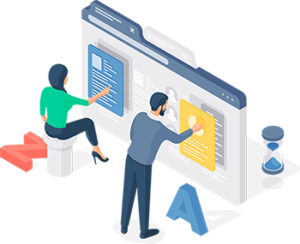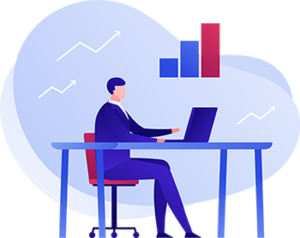Choosing the right analytics solution isn’t easy.
Successfully navigating the 20,000+ analytics and business intelligence solutions on the market requires a special approach.
Read on to learn how data literacy, information as a second language, and insight-driven analytics take digital strategy to a new level.
 People-process-technology speak is no longer enough to traverse the technological landscape.
People-process-technology speak is no longer enough to traverse the technological landscape.
C-level executives and professionals alike must learn to speak a new language – data. This critical capability propels organizations forward in today’s digital-first era.
The benefit of speaking data, a.k.a. Information as a Second Language (ISL), lies entirely in the value of achieving business outcomes through analytics and business intelligence (BI). ISL is also the foundation for the process of transforming data into wisdom and successful master data management.
A Modern Approach is Needed
Fear of disruption and growing digital transformation initiatives have created a demand for business-driven analytics. Gone are the days of centralized, IT-driven, BI capabilities (gasp!). But the reasoning is sound.
Modern era business stakeholders need current and relevant insights from across business units and processes. Traditional data sources like end of month statements and quarterly reports are no longer enough. Access to enterprise-wide information fuels analytics solutions and enable a new approach for decision making.
Technology to the rescue!
Well, almost. Selecting the best analytics and BI technology solution for you budget and organization doesn’t guarantee positive business outcomes. This is because the very best results are only achieved when core business actions are supported by clusters of analytics outcomes.
And what are these clusters of outcomes? They’re the insights needed for better decision making, and they start with the business, not with the data. It’s not about the technology – or solving the data silo problem. It’s all about the approach.
Business Focus is Required for Success with Transformative Analytics Technologies
 So, how can we bridge the gap between positive business outcome and the technology required to get there? Increasing data literacy is the answer.
So, how can we bridge the gap between positive business outcome and the technology required to get there? Increasing data literacy is the answer.
In fact, according to a recent Gartner, Inc. annual chief data officer survey, respondents said that the second most significant roadblock to progress with data and analytics is poor data literacy. You can probably imagine that the top roadblock was culture challenges to accept change. And that’s a topic for another time!
Data literacy is the most crucial factor for successfully aligning your organization’s most important and urgent business outcomes with the most effective analytics and BI solutions.
The reason data literacy plays such an important role in choosing the right technology solutions is that it directly impacts the quality of the requirements list. And a better, more accurate requirements list always maximizes cost-savings and overall effectiveness of a solution.
Incidentally, this topic came up a couple of times in this conversation with a data scientist.
Connect the Dots Between Data Literacy, ISL, and the Requirements List
Data literacy is solved by a structured program of learning information as a second language (ISL). ISL eliminates data literacy by modeling the way we learn spoken language.
While there are paid and free resources that address data literacy, the best approach is to incorporate your organization’s culture and existing technical vocabulary with off-the-shelf resources. You can read more on the basics of creating an ISL program here.
The most important thing to understand is that ISL is a complete system of learning, not just a list of generic terms and definitions. It includes the reports, charts, dashboards, and terminology unique to your organization.
ISL helps today’s business leaders understand how data answers business questions.
Because business stakeholders have the best understanding of what success needs to look like, they’re accountable for communicating the requirements for how to get there. Knowing the right business questions to ask is only half of the equation.
Choosing the best analytics and BI platform for solving business problems requires non-technical workers to “speak data.”
A baseline understanding of data enables the proper communication required to “be on the same page” with data scientists and engineers.
Translating desired business outcomes into the language of information enables a much deeper command over both the technology selection process and the technology itself.
ISL is a crucial factor to empower digital transformation and decrease the threat of disruption.
There are three common pools of knowledge within ISL:
Applied analytics
Business analytics
Machine learning and data science
Applied Analytics
Applied analytics is all about building a business analytics portfolio of actionable insights which directly affect and improve business processes.
Think of applied analytics as specific use cases for your industry that identify the exact insights and data that would create the best outcomes in specific business processes. A deeper understanding of modern approaches to collecting and managing data leads to the discovery of new sources of data.
Here’s where you dream big! If you could know anything about a process that you think would be helpful to achieve the desired outcome, what would that information be?
 Imagine a business process for creating negative churn. You’re concerned with engagement, end-user demographics, vertical / lead-source data, service issues, and the list goes on and on. Imagine looking in-between the current data points you have and discovering what’s happening there.
Imagine a business process for creating negative churn. You’re concerned with engagement, end-user demographics, vertical / lead-source data, service issues, and the list goes on and on. Imagine looking in-between the current data points you have and discovering what’s happening there.
You would benefit from finding out how customers feel about you on social media. You’d probably like to know if your customers are generally happy with your product or if they are shopping around. Or, if your customer service reps are doing a good job empathizing with customers. The list of insights that fill in traditional process gaps is endless.
By starting with the insights and determining where in a business process you need them, you ensure the success of both the analytics project and the business process.
Take the value of insights to a higher level by focusing on two types of insights:
- Highly refined insights that are extremely valuable to core people within your organization
- Highly refined insights that are of lower value, but can be consumed more broadly across your organization
By taking the organization as a whole into consideration, analytics projects take on a whole new level of value and complexity. There are solutions for unifying data across data silos, but the more information that is made easy to consume, the greater the benefit.
Sales data helps services prepare and predict changes in volume. Services data helps product development understand and predict trends and market changes. Today, more business leaders are becoming data literate and focusing on solving business problems with data. These pioneers are disrupting long-seated competitors and driving massive industry change. This is especially true in financial services and with technology and service providers.
Key Language of Applied Analytics
The vocabulary of applied analytics includes words and concepts such as:
- Key performance indicators (KPIs)
- Master data management
- Data governance
- Reporting
- Scoring – i.e. profitability or risk
- Databases, tables, and columns
- Primary keys
- 2D data
- Structured, semi-structured, and unstructured data
- Data pipelines
- Web scraping
Business Analytics
Business analytics is a focus on practical requirements needed for understanding current performance and for predicting future outcomes. It’s essentially a method for ongoing fact-based decision-making by end-users – modern business problem solving.
 These requirements include fluency in:
These requirements include fluency in:
- Analytical models
- Simulations
- Data science skills
- Technology – i.e. data mining, predictive analytics, and statistics
- Best practices for exploring collected data
Data is crucial to the success of business analytics. Just as Henry Ford used data to ensure success in the early 1900’s, we also depend on volumes of high-quality data.
This data is critical for answering questions such as:
- “Why is this happening?”
- “What if this trend continues?”
- “What’s going to happen next?”
- “What’s the best that can happen?”
Examples of Business Analytics
Banks use analytics to differentiate customers and align product offerings based on credit risk, usage, and other characteristics. They do this in real-time.
Another significant use case is customer loyalty programs. Advanced loyalty programs track detailed patterns like where consumers are spending money, where they are shopping, and what coupons, or redemption codes they use.
A classic example often cited is John Deere’s innovative investment in a new way of optimizing inventory called “direct derivative estimation of non-stationary inventory.” It saved the company $1.2B.
Getting Started with Business Analytics
One of the most difficult, but necessary steps to achieve business value from analytics is integrating data across different systems. Because database architectures are more application-centric than data-centric, building master data sources is a time-consuming process.
If you’re interested in making applications more data-centric, check out the principles of the data-centric manifesto here.
Because business analytics is focused on both current and future outcomes, real-time access to insights from data is now a requirement. So, not only do we have a new list of data sciences technology to understand, we also have new data infrastructure needs as well.
The success of business analytics lies in a few core objectives:
- An organization dedicated to improving data literacy
- Use of analytics to make decisions across multiple business units or functions
- Enterprise management and use of analytical tools, data, and data science capabilities
Machine Learning and Data Science
Machine learning (ML) centers around the learning process of computers. When we refer to ML, we are mainly talking about the process of automating and improving a machine’s ability to perform a task based on what it has learned.
Machine Learning is King, Data Science the Heart
In the realm of artificial intelligence, ML is king. And at the heart of ML is data science.
What is Data Science?
Data science is a field of study which involves scientific methods, programming skills, math (calculus, algebra, and statistics), and algorithms to transform data into knowledge.
To work with ML, sample data is used to train software to discover patterns or outcomes in very large data sets. The best use-cases for ML involve data that humans would have a difficult time working with.
How Machine Learning is Used
ML platforms with built-in data science functionality like Grooper, and software, like Python, or R enable data scientists to solve problems that can’t be solved with traditional programming. In order to train ML technology, example inputs and outputs are provided. In the case of image recognition, it may take anywhere from hundreds to millions of image samples just to train a single category or thing.
Recognizing text and certain features of a document require training as well. Although the challenges with text are different, the same principles apply.
Data science, combined with ML technologies, gives organizations the ability to deliver relevant, timely insights to decision makers. The full potential of these technologies is only unlocked when the demands of the business and the desired outcomes drive innovation.
Although data is the foundation and lifeblood of ML and data science, creating a data strategy that is focused on both data quality and business outcomes is critical.
From here on out, I’ll refer to ML and data science as just AI. Most organizations are eager to cash in on the potential value in AI. However, finding realistic use-cases, and building a solid road map are major barriers to adoption.
The ultimate goal of AI is accelerating the delivery of data-driven insights and knowledge acquisition.
Prepare for New Data Initiatives by Understanding:
- Machine learning
- Data science approaches
- Algorithms
- Bias
- Data and analytics strategy
- Data quality
- Data preparation
Where to find More Information on Cloud-Based Practical AI Offerings
- Amazon Machine Learning
- Google Cloud Machine Learning Engine
- IBM Watson Studio
- Microsoft Azure Machine Learning Studio
Meet Accelerating Demand for Business Growth Head-On
The most effective way to meet the growing demands of the increasingly digital enterprise is with adequate data and analytics strategies and practices. Data analytics isn’t new, and neither is machine learning or data science. So, what gets in the way?
Business-First Focus
The first barrier to successful adoption of AI-powered analytics solutions is getting past the data-first mentality. As Stephen Covey so famously said, “Begin with the end in mind.” Starting with the needed business insight and outcomes paves the way to success.
Information as a Second Language (ISL)
Enterprise-wide data literacy is a barrier to innovation. Increasing data literacy is a massive game-changer for data-driven organizations. Becoming a digital native isn’t optional.
Organizations must adopt formal ISL programs to increase the digital fluency of workers at every level.
Expand Knowledge Beyond People-Process-Technology Speak
Increasing data literacy makes choosing an analytics platform easier.
It enables better decision-making using data, and it ensures you stay ahead of disruption by achieving more success with digital transformation projects.
Start your ISL learning program off in the right direction. Focus on the three pools of knowledge: applied analytics, business analytics, and machine learning and data science. Streamline and strengthen core operations by achieving insight-driven analytics projects.
Discover great business analytics solutions
References:
Davenport, Thomas H.; Harris, Jeanne G. (2007). Competing on analytics: the new science of winning. Boston, Mass.: Harvard Business School Press. ISBN 978-1-4221-0332-6